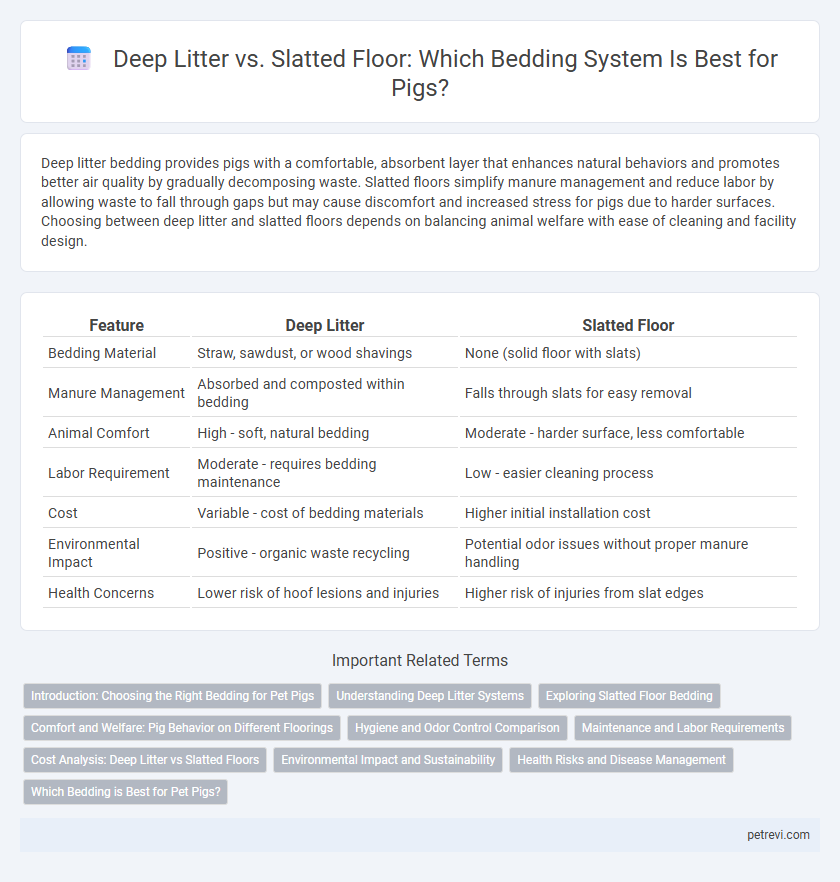Deep litter bedding provides pigs with a comfortable, absorbent layer that enhances natural behaviors and promotes better air quality by gradually decomposing waste. Slatted floors simplify manure management and reduce labor by allowing waste to fall through gaps but may cause discomfort and increased stress for pigs due to harder surfaces. Choosing between deep litter and slatted floors depends on balancing animal welfare with ease of cleaning and facility design.
Table of Comparison
| Feature | Deep Litter | Slatted Floor |
|---|---|---|
| Bedding Material | Straw, sawdust, or wood shavings | None (solid floor with slats) |
| Manure Management | Absorbed and composted within bedding | Falls through slats for easy removal |
| Animal Comfort | High - soft, natural bedding | Moderate - harder surface, less comfortable |
| Labor Requirement | Moderate - requires bedding maintenance | Low - easier cleaning process |
| Cost | Variable - cost of bedding materials | Higher initial installation cost |
| Environmental Impact | Positive - organic waste recycling | Potential odor issues without proper manure handling |
| Health Concerns | Lower risk of hoof lesions and injuries | Higher risk of injuries from slat edges |
Introduction: Choosing the Right Bedding for Pet Pigs
Deep litter bedding for pet pigs offers superior moisture control and natural insulation by accumulating organic material, which promotes beneficial microbial activity that reduces odors and enhances pig comfort. Slatted floors provide efficient waste drainage and easy cleaning, minimizing disease risks but may reduce the pig's ability to exhibit natural rooting behaviors. Selecting appropriate bedding depends on balancing hygiene, comfort, and behavioral needs specific to pet pigs' welfare and management.
Understanding Deep Litter Systems
Deep litter systems for pig bedding involve layering organic materials like straw, wood shavings, or sawdust that decompose over time, creating a natural composting environment. This method improves manure management by reducing odor and promoting beneficial microbial activity, enhancing animal welfare and hygiene. Compared to slatted floors, deep litter supports pigs' natural behaviors, provides thermal insulation, and lowers ammonia emissions, contributing to sustainable pig farming practices.
Exploring Slatted Floor Bedding
Slatted floor bedding in pig farming enhances waste management by allowing manure to fall through gaps, reducing ammonia buildup and improving hygiene. This system supports better hoof health and minimizes labor by eliminating the need for frequent bedding replacement compared to deep litter setups. Optimal slat design ensures comfort while maintaining airflow, promoting pig welfare and productivity.
Comfort and Welfare: Pig Behavior on Different Floorings
Deep litter systems provide a comfortable and natural environment that encourages pigs to exhibit rooting and nesting behaviors, enhancing overall welfare. Slatted floors, while easier to clean, can cause discomfort, hoof injuries, and stress due to limited traction and reduced contact with soft bedding. Studies show pigs on deep litter floors display more natural behaviors, resulting in improved health, reduced aggression, and better growth performance.
Hygiene and Odor Control Comparison
Deep litter bedding in pig housing enhances hygiene by allowing manure to decompose naturally, reducing ammonia buildup and promoting beneficial microbial activity that controls odor effectively. Slatted floor systems facilitate immediate manure removal through gaps, minimizing contact between pigs and waste, which improves hygiene but may concentrate odor below the floor requiring efficient ventilation. Comparing both, deep litter provides better odor absorption and moisture regulation, while slatted floors offer quicker waste elimination but necessitate advanced odor management technologies to maintain air quality.
Maintenance and Labor Requirements
Deep litter systems for pig bedding require less frequent cleaning as the organic matter decomposes naturally, reducing labor intensity and ongoing maintenance costs. Slatted floors demand regular manure removal underneath the flooring to prevent buildup, necessitating higher labor input and more consistent maintenance schedules. The deep litter approach promotes a lower labor workload but requires monitoring to manage moisture and ammonia levels effectively.
Cost Analysis: Deep Litter vs Slatted Floors
Deep litter systems typically incur lower initial construction costs compared to slatted floors, which require complex installation and durable materials to support waste removal systems. Operational costs for deep litter can be higher due to regular bedding replacement, but these may be offset by improved pig health and reduced labor for manure management. Slatted floors demand ongoing maintenance and energy expenses for slurry systems, potentially increasing total long-term costs despite facilitating efficient waste handling.
Environmental Impact and Sustainability
Deep litter systems for pig bedding significantly reduce environmental impact by promoting natural decomposition and minimizing waste runoff, enhancing soil fertility through nutrient recycling. Slatted floors, while enabling efficient manure collection, often lead to concentrated waste that can increase ammonia emissions and require energy-intensive waste treatment methods. Sustainable pig farming increasingly favors deep litter approaches due to their ability to improve animal welfare, reduce greenhouse gas emissions, and support circular nutrient management.
Health Risks and Disease Management
Deep litter bedding in pig farming reduces respiratory issues by absorbing moisture and minimizing ammonia levels, promoting better air quality and reducing pathogen spread. Slatted floors facilitate easier manure removal, decreasing parasite buildup but may increase joint stress and lameness risks due to hard surfaces. Effective disease management depends on balancing hygiene maintenance with animal comfort, where deep litter aids natural behavior while slatted floors improve sanitation efficiency.
Which Bedding is Best for Pet Pigs?
Deep litter bedding offers superior comfort and natural insulation for pet pigs by allowing them to root and nest, promoting healthier behavior and reducing stress. Slatted floors provide excellent drainage and cleanliness but can be harsh on pig feet and joints, leading to discomfort and potential health issues. For pet pigs, deep litter bedding is generally the best choice, ensuring a softer, more enriching environment that supports their well-being and natural instincts.
Deep litter vs Slatted floor for Pig bedding Infographic

 petrevi.com
petrevi.com